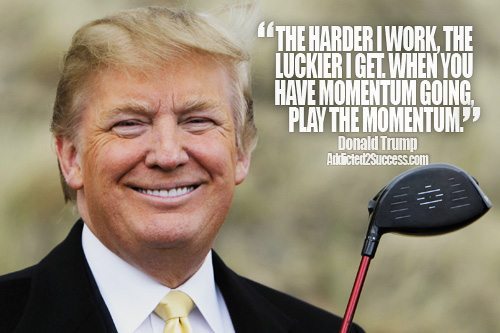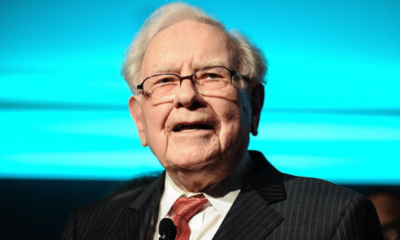Entrepreneurs
The Success of Donald Trump
Donald Trump has used a combination of persistence, determination, confidence and calculated risk taking to become a success.
Donald Trump’s estimated net worth is $4 Billion.
Donald Trump became a Billionaire through his hugely profitable real estate endeavours and is president of The Trump Organization and the Founder of Trump Entertainment Resorts.
Trump has bounced back from adversity several times to not only become a billionaire but one of America’s most well known celebrities and a TV personality.
Donald Trump’s Early Career
 The son of a real estate developer Trump seemed to have been inspired to take the same career path as his father. However, Trump junior had a bigger vision of the future that his dad did. When he was still at College Trump worked for his father during the summer and then began working for his father full time after his graduation. He was responsible for the financing of an expansion of their company by persuading his father to be more adventurous when taking out loans based on the equity held in their apartment complexes. That being said, it was a competitive business and the margins were very tight.
The son of a real estate developer Trump seemed to have been inspired to take the same career path as his father. However, Trump junior had a bigger vision of the future that his dad did. When he was still at College Trump worked for his father during the summer and then began working for his father full time after his graduation. He was responsible for the financing of an expansion of their company by persuading his father to be more adventurous when taking out loans based on the equity held in their apartment complexes. That being said, it was a competitive business and the margins were very tight.
After moving to Manhattan, New York in 1971 Donald Trump became friendly with several ‘big players’. As he became increasingly aware of economic opportunity in the city Trump played a part in large property developments that would yield high profits through the use of modern design and gaining recognition from the public.
A turning point arrived in 1974 when Trump gained an option on one of the Penn Central’s hotels, the Commodore which wasn’t turning a profit but was in a great location near Grand Central Station. Within a year Trump had sealed a partnership agreement with Hyatt Hotels who, at the time, didn’t have a large downtown hotel. After a complex deal with the city to arrange finances, abate taxes and renovate the building, the hotel opened as the Grand Hyatt and was a huge economic success which made Donald Trump the City’s most recognised and most controversial property developer.
“If you’re interested in ‘balancing’ work and pleasure, stop trying to balance them. Instead make your work more pleasurable.” – Donald Trump
The Growth of an Empire
 Trump leased a site on Fifth Avenue adjacent to the famous Tiffany & Company in 1979. This was to be the location for the huge apartment-retail complex designed by Der Scutt and was to cost $200 Million. The aptly named ‘Trump Tower‘ opened in 1982 with fifty eight stories complete with six story atrium lined with pink marble and an eighty foot waterfall. Trump gained nationwide attention when the luxurious building attracted world-renowned retail stores and celebrity renters.
Trump leased a site on Fifth Avenue adjacent to the famous Tiffany & Company in 1979. This was to be the location for the huge apartment-retail complex designed by Der Scutt and was to cost $200 Million. The aptly named ‘Trump Tower‘ opened in 1982 with fifty eight stories complete with six story atrium lined with pink marble and an eighty foot waterfall. Trump gained nationwide attention when the luxurious building attracted world-renowned retail stores and celebrity renters.
This was not Trump’s only project at the time, he was also researching the profitability of the casino, gambling business that was approved in New Jersey in 1977. Once again being keen to take the opportunity, Trump purchased a property in Atlantic City where he enrolled his younger brother to help him win a gambling license, financing and other permits. The parent company of Harrah’s Casino Hotels, Holiday Inn Corporation offered to partner with Trump and the $250 Million complex named Harrah’s at Trump Plaza opened its doors in 1982.
In 1986 Trump bought out The Holiday Inn Corporation renaming the property Trump Plaza Hotel. It was around this time that Trump also bought a Hilton Hotel owned resort when they failed to be granted a gambling license, renaming the $320 Million facility Trump’s Castle. Not stopping there, Trump progressed to purchase the largest casino-hotel complex in the world, the Atlantic City Taj Mahal which opened its doors in 1990.
“I wasn’t satisfied just to earn a good living. I was looking to make a statement.” – Donald Trump
Donald Trump’s Amazing Recovery
 Trump wanted to expand his business and opted to build a condominium project in West Palm Beach, Florida and in 1989 he bought the Eastern Airlines Shuttle changing the name to Trump Shuttle. In the early part of 1990 Trump made his way to LA to reveal a plan to develop a $1 Billion facility for commercial and residential purposes, featuring a one hundred and twenty five story office building.
Trump wanted to expand his business and opted to build a condominium project in West Palm Beach, Florida and in 1989 he bought the Eastern Airlines Shuttle changing the name to Trump Shuttle. In the early part of 1990 Trump made his way to LA to reveal a plan to develop a $1 Billion facility for commercial and residential purposes, featuring a one hundred and twenty five story office building.
It was in that same year that the Real Estate Market experienced a downturn which negatively impacted the value and income of Trump’s empire with his personal net worth free falling from an estimated $1.7 Billion to $500 Million. Trump and his organization had to work extremely hard to get many loans to stop the whole empire from falling apart which led many to ask whether or not the company could survive bankruptcy. Trump’s fall from grace was viewed by many as a symbol of the social, business and economic excesses of the previous decade.
However, the story does not end there. Remarkably, Donald Trump fought his way back from nearly $900 Million in debt to a net worth of nearly $2 Billion by 1997!
Conclusion
It may seem like a cliché that to become a successful entrepreneur you have to take calculated risks and be able to bounce back even when times get extremely tough but Donald Trump is living proof of these attributes.
Trump is an amazing man who really has always done what ever it takes to make his visions a reality and has never taken no for answer even when a recovery was seemingly impossible.
Donald Trump Picture Quote

Change Your Mindset
The Silent Skill That Makes People Respect You Instantly
What truly earns respect and why most people go about it the wrong way

Everybody craves respect but not everyone earns it. Some people believe that a title, years of experience, or a position of authority automatically entitles them to respect. (more…)
Entrepreneurs
The Essential Skills Every Entrepreneur Needs In 2026
Success in the digital age isn’t about luck. It’s about mastering the skills that separate dreamers from doers.

When I was 22 years old, I started my first side hustle as a ghostwriter. (more…)
Business
The Hidden Money Pit in Your Operations (and How to Use It)
See how smart asset management software is quietly saving businesses thousands in wasted time, stock, and maintenance.

Trimming unnecessary expenses and minimizing resources is a general practice in running a business effectively. Asset management software can help you achieve those goals. (more…)
Business
Thinking of Buying A Business? These 6 Sectors Quietly Produce the Best Deals
Before you buy your next venture, check out the sectors where successful businesses are changing hands every day.

All entrepreneurs have a desire to be the masters behind a successful venture. Buying an established business is a great choice for many. This provides instant access to an established market with existing infrastructure and clients. (more…)
-

 Business4 weeks ago
Business4 weeks agoWhy Your E-Commerce Fulfilment Is Probably Broken (And How to Fix It)
-

 Shift Your Mindset3 weeks ago
Shift Your Mindset3 weeks ago11 E’s That Define Every Great Leader And Why Most People Miss Them
-

 Did You Know3 weeks ago
Did You Know3 weeks agoThe Success Patterns You Inherited (And Didn’t Notice)
-

 Entrepreneurs2 weeks ago
Entrepreneurs2 weeks agoThe Essential Skills Every Entrepreneur Needs In 2026
-

 Business3 weeks ago
Business3 weeks agoThe Hidden Money Pit in Your Operations (and How to Use It)
-

 Change Your Mindset2 weeks ago
Change Your Mindset2 weeks agoHow to Turn Your Mind Into Your Greatest Asset (Instead of Your Enemy)
-

 Change Your Mindset1 week ago
Change Your Mindset1 week agoThe Silent Skill That Makes People Respect You Instantly
-

 Life7 days ago
Life7 days ago10 Research-Backed Steps to Create Real Change This New Year



























2 Comments